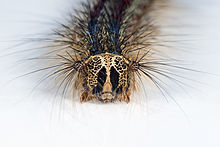Gypsy moth
| Gypsy moth | ||||||||||||
|---|---|---|---|---|---|---|---|---|---|---|---|---|

Gypsy moth ( Lymantria dispar ) (male) |
||||||||||||
| Systematics | ||||||||||||
|
||||||||||||
| Scientific name | ||||||||||||
| Lymantria dispar | ||||||||||||
| ( Linnaeus , 1758) |


The gypsy moth ( Lymantria dispar ) is a butterfly ( moth ) from the subfamily of the bearer moth (Lymantriinae) within the family of Erebidae .
features
Gypsy moths are characterized by a pronounced sexual dimorphism .
Similar species
- Nun ( Lymantria monacha ) (Linnaeus, 1758)
Appearance of the male
The slender male has a wingspan of 38 to 40 millimeters. The forewings are gray-brown with blurred black zigzag bands. The hind wings are lighter and of a brownish color. The antennae have long comb teeth. In contrast to the females, the male gypsy moths are agile and persistent flyers.
Appearance of the female
The plump female has a wingspan of 60 to 62 millimeters. The wings are dirty white. The forewing pair has a sharply drawn black serrated band. The female's body is thick and ends in a bead of brown anal wool . The female only travels at dusk, flies very poorly and with great difficulty and lays her 300 to 500 eggs (even more than 700) in large brownish sponges made of mucus and anal wool (so-called ice mirrors or egg sponges). The eggs are protected from the cold and hidden from predators by the hair that comes from the female's body. She cemented these to tree trunks and fences. The sponge moth got its name from the sponge-like appearance of the clutch.
Eggs and caterpillars
The eggs are pale red at first and then gradually turn a dark gray. The females prefer to lay their eggs on the south side and the lower parts of deciduous trees. The caterpillars are 40 to 70 millimeters long just before pupation. The caterpillars from which the females develop are the larger.
The caterpillars are colored gray, ash gray or gray-yellow. The caterpillars are finely spotted and have blue and red warts. On these they have fine, long wart hairs, sometimes stinging hairs . The eggs overwinter and the caterpillars hatch in the following spring.
Damage
The damage done by the gypsy moth is caused by the caterpillars. After hatching, caterpillars only stay near the nest or sponge for a few days. Then they begin to move into the treetops, where they initially eat holes in young leaves. With increasing age and size, they consume the leaves almost completely. The damage is then visible from afar; in the case of mass infestation, trees are partially completely defoliated. In addition to fruit trees, oak and hornbeam in particular are heavily infested. Most of the damaged trees will turn green again when the caterpillars stop feeding at the end of June. Occasionally oak trees in particular die. If oak stands are weakened by other diseases, pests or a period of drought, the entire stand can be lost.
Distribution area
Gypsy moths are common in the warmer areas of Europe and North Africa. The species can also be found in the Central Asian mountains and the forest region of Siberia. The gypsy moth is also found in the Altai Mountains and in the Baikal region to Mongolia , China , Korea and Japan . In the 19th century, the gypsy moth was kidnapped by the entomologist Étienne Léopold Trouvelot to Medford, Massachusetts , from where it spread across the United States until the middle of the 20th century and is now one of the most feared pests.
Combat
The mass reproduction of the gypsy moth in oak forests is combated with tebufenozide . Biologically used predators are bracon wasps and caterpillar flies .
swell
literature
- Karl Eduard Schedl : The gypsy moth (Porthetria dispar L.) in Euroasia, Africa and New England. Monographs on Applied Entomology, No. 12. Parey, Berlin 1936
- Günter Ebert: The butterflies of Baden-Württemberg. Volume 4, Moths II (Bombycidae, Endromidae, Lemoniidae, Saturniidae, Sphingidae, Drepanidae, Notodontidae, Dilobidae, Lymantriidae, Ctenuchidae, Nolidae). Ulmer Verlag, Stuttgart 1994, ISBN 3-800-13474-8
- Wolfgang Schwenke (Hrsg.) Among others: The forest pests of Europe. A manual in 5 volumes. Volume 3: Butterflies . Parey, Hamburg and Berlin 1978, ISBN 3-490-11316-0
- Fritz Schwerdtfeger : The forest diseases. Textbook of forest pathology and forest protection. 4th revised edition, Parey, Hamburg and Berlin 1981, ISBN 3-490-09116-7
Individual evidence
- ↑ a b H. Eikamp, R. Hohmann: Native butterflies: Schwammspinner, Lymantria dispar (PDF file; 499 kB). P. 2. ISSN 0934-1366
- ↑ M. Lehmann: Gypsy Moth (Lymantria dispar L.) . LVLF Plant Protection Service. P. 3
- ↑ Franconian forests sprayed with insecticide: This pest is the reason. In: Nürnberger Nachrichten . May 2, 2019, accessed May 3, 2019 .
- ↑ Caterpillars eat everything bare. In: Kölner Stadt-Anzeiger . June 18, 2019, accessed June 19, 2019 .
Web links
- The gypsy moth (Lymantria dispar L.) - WSL information sheet for practice - PDF (288 kB)
- Lepiforum e. V. Taxonomy and Photos
- www.schmetterling-raupe.de
- Moths and Butterflies of Europe and North Africa (English)
- Guide to the moths of Great Britain and Ireland (English)
- Collection of the Natural History Museum Stockholm (Swedish)
- Markku Savela: Lepidoptera and some other life forms (English)
- Lymantria dispar in Fauna Europaea

